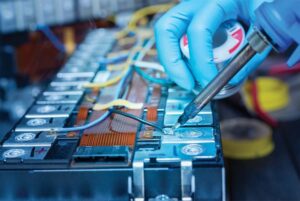Battery management systems (BMS) software can be defined as electronic control circuits that can monitor and regulate the charging and discharge of batteries.
 According to the latest findings of ABI Research, advanced Battery Management System (BMS) software could save automakers US$18 billion annually in 2030, equivalent to US$76 billion cumulatively from 2024.
According to the latest findings of ABI Research, advanced Battery Management System (BMS) software could save automakers US$18 billion annually in 2030, equivalent to US$76 billion cumulatively from 2024.
ABI Research finds that intelligent BMS software can reduce the size of Electric Vehicle (EV) batteries without reducing their range.
This reduces the cost to OEMs of manufacturing EVs, helping them to mitigate the effects of limited battery production and achieve profitability.
“OEMs are struggling with two competing issues: the demand from customers for EVs with a greater driving range and the shortages of EV batteries due to restricted supplies of critical minerals and limited manufacturing capacity.
Advanced BMS software allows EV batteries to be charged to a higher level and discharged to a lower level without being damaged or aging prematurely, increasing their usable capacity and addressing both problems. These solutions can be adopted purely through software, running as AUTOSAR applications to augment the existing BMS capabilities,” says Dylan Khoo, Electric Vehicles Analyst at ABI Research.
Qnovo’s SpectralX is an example of an intelligent software-only BMS solution that can not only improve range by 10% but also enable faster charging and minimize degradation to extend an EV battery’s lifespan. This technology could allow the global EV industry to reduce required battery production in 2030 by around 300 GWh, significantly alleviating the stress on the battery supply chain and manufacturing costs.
Outside of the software space, wireless BMS (wBMS) hardware will also help to reduce costs by allowing batteries to forgo connectivity wires. Wire harnesses are expensive and time-consuming to install and maintain and add weight, volume, and points of failure to the battery. GM is the first major automaker to adopt a wBMS with its Ultium platform, developed in collaboration with Analog Devices and Visteon.
Major component suppliers such as Marelli, NXP, and TI have wBMS offerings as well; ABI Research expects that the cost benefits of this technology will lead to it being the leading solution in the next generation of EV platforms.
“Aside from Tesla, most OEMs are currently struggling to turn a good profit on their EVs. Ford, for example, is expecting to have a US$3 billion loss pretax on its EV business this year. A key factor in this is the high cost of batteries and difficulties in scaling production to match the rapidly growing demand. BMS software effectively gets more energy out of a smaller battery and cuts production costs. As an application layer solution, it can be applied to a wide range of battery formats without requiring changes in design or manufacturing,” Khoo concludes.
These findings are from ABI Research’s Battery Management Systems for Electric Vehicles application analysis report. This report is part of the company’s Electric Vehicles research service, which includes research, data, and ABI Insights. Based on extensive primary interviews, Application Analysis reports present an in-depth analysis of key market trends and factors for a specific technology.
